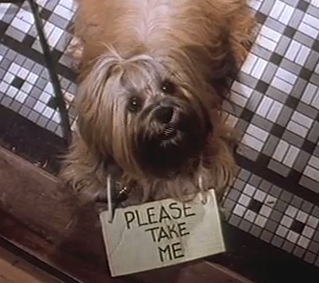
I’m teaching Documentary Film this semester, and this past week, I agreed to fill in for the professor who teaches Screenwriting. This was probably unwise to begin with, as it meant I’d be teaching a 6:30-10:05 pm class the day after returning from two weeks in Spain, so according to the clock in my head, I’d start teaching the class after midnight — right after 3.5 hours spent teaching my own class, as if I wouldn’t be tired enough. But I needed someone to cover a class for me in October, so I didn’t really think the whole thing through.
“You may want to show a short film or two, then talk about some of the production issues the filmmaker might have faced,” the professor I was subbing for suggested in an email, knowing that I work in production. This seemed like a good idea, except for the fact that I have hardly seen a short film since I graduated from film school in 1995, and the ones I have seen were terrible. Like the one I saw at Rooftop where a kid goes to a party with a girl he really likes, and they take drugs together that really mess them up, and he sees her getting raped while she’s unconscious by a random guy, so he undresses and lies next to her so that when she wakes up, she says, “I’m sorry I don’t remember, but I’m glad my first time was with you.” Yeah, not so much. So I decided to show some clips from TV shows and films I’d worked on (getting in two Sopranos episodes, to bolster my cred), but also a clip from my own thesis film, Fear of Dogs.
I’d known for a long time — probably since I’d finished shooting it in 8 days in 1993 — that Fear of Dogs hadn’t quite turned out the way I’d wanted. When I was done editing the film and sent it to festivals, it hadn’t done well. It had made it into one semi-known festival, Chicago (now a much bigger deal than it was then), and had actually won the Student Film Silver Plaque, but this didn’t mean very much to me considering that they hadn’t screened it at the festival, so nobody actually saw it. (This was my first but not last experience with festival awards being given out just for the sake of giving out awards. Flat Daddy won Best Educational Film at the Las Vegas Film Festival. This would have been odd since I think of an “educational film” as something that gets shown on a filmstrip during Driver’s Ed and has the voiceover of a man from 1956 telling you to “give a friendly tap of the horn” when driving through a four-way intersection, except that Las Vegas turned out to be a festival where literally every single film was given an award). By the mid-90s, though, I’d given up believing that festival and award recognition was the only thing that distinguished films, and filmmakers, as good or bad. The lack of Academy Award winners that hadn’t been box office successes, or hadn’t been made by white men, contributed to that, but it was also something I’d had to do to make it through film school. If you read this blog (most recently this post), you know that I’ve worked hard and not especially successfully to develop the kind of ego that it takes to be a creative person in this industry. Still, having spent years writing and casting and shooting and editing and sending out my 23-minute opus, for the next several I still felt just too close to/sick of it to think about it critically, much less any urge to just pop in the VHS tape and stroll down memory lane. When people asked me about the film I said, “Well, I wrote it when I was 23,” and that seemed enough of an explanation for why I wasn’t going to show it to them.
I finally watched the film again when I had it transferred to DV and digitized it into Final Cut Pro maybe ten years ago (it was shot on 16mm and my video copy was on Beta), so that I could use a piece of it for my directing reel. The first thing that struck me wasn’t the unnatural dialogue, although that was still there, but how off the timing felt, of everything. As I tried to choose a clip to use, I found myself getting sucked into doing some re-editing — I know, I know — to try and make certain scenes move faster, but soon I realized that that wouldn’t solve the problem. Sure, I’d also been stuck with wheelchair dolly shots (if you’re not familiar with what this is, it’s putting the DP, with a camera, in an actual wheelchair and pushing them around to simulate the effect of a dolly) that hadn’t moved quite as fast as I’d wanted, both because I’d avoided doing too many takes in order to stay on schedule and because a fast wheelchair dolly shot feels about as smooth as the experience of driving my old 1996 Camry through Red Hook. But it wasn’t just the editing and the camera moves that were too slow, it was the performances too. Why hadn’t I asked the actors to do it again, but faster? Then I remembered that in 1993, I’d been really into the films of Jim Jarmusch. Clearly, I thought that I, too, was making Mystery Train or Stranger Than Paradise, not realizing that that pacing didn’t necessarily match the script that I’d written, which was more screwball comedy than avant-garde deadpan. So, while it wasn’t exactly fun finally watching Fear of Dogs again, I remembered considering it an eye-opening experience, one which helped me get some perspective on the film and my feelings about how it had turned out. It was what it was, it had its good points and its bad points, and, now, more than 20 years after I’d completed it, I thought was okay with that.
Yeah, not so much. When I screened my clip from Fear of Dogs for the screenwriting students last week, I immediately was hit again by the stilted dialogue, the slow delivery, the fact that the big visual punchline of the scene didn’t read in the wide shot that was supposed to deliver it, and the timing of that fucking dolly shot. But the thing that really hurt was that nobody laughed. I was showing one scene, out of context, on purpose, just so that I could talk about the production challenges I’d faced, the students had basically had no idea what what was going on in the film at all, and yet, I somehow managed to feel pain over that. Yes, I still saw that the actors had some really nice moments, and I noticed how much I liked the look of the shots, and I was still happy with the music, but none of that could outweigh the big, fat feeling of failure.
Sadly, I think that’s just how we learn to judge films, including our own. We don’t generally look at their good points and bad points analytically, we don’t weigh the production troubles that someone faced or the fact that they were a young film student at the beginning of learning their craft, or the fact that they were really, mistakenly, into Jarmusch. Critics and journalists do this sometimes, but rarely; in general, a film that’s not bad but could have been better isn’t a story. Something is either good or it isn’t. Someone is either talented, the next big thing, or they’re nothing. That’s why, when we try to look at our own films for what worked and what didn’t and why, we feel like like we’re just making excuses. So instead of analyzing our failures, we just let them gather dust and we never really learn from them, and we never really get over them — and we still have to sell them as successes. Oh, that film? It won the Student Film Silver Plaque! (I did, in fact, say that when one of the students last week asked me if it had made it into in any festivals).
Does this mean I’m now going to hunker down for the next few days, watch all of my old student films and read all of my old screenplays and see what I can learn about my creative process? Hell no. But I’ve spent more time thinking constructively about Fear of Dogs to write this post than I’ve spent over the entire 20-odd years since I made it, and that’s just kind of ridiculous. We’re never going to get better at the work we do if we can’t bear to think about what we did wrong, and right, and without letting one obscure the other – and laughing about it, just a little.
